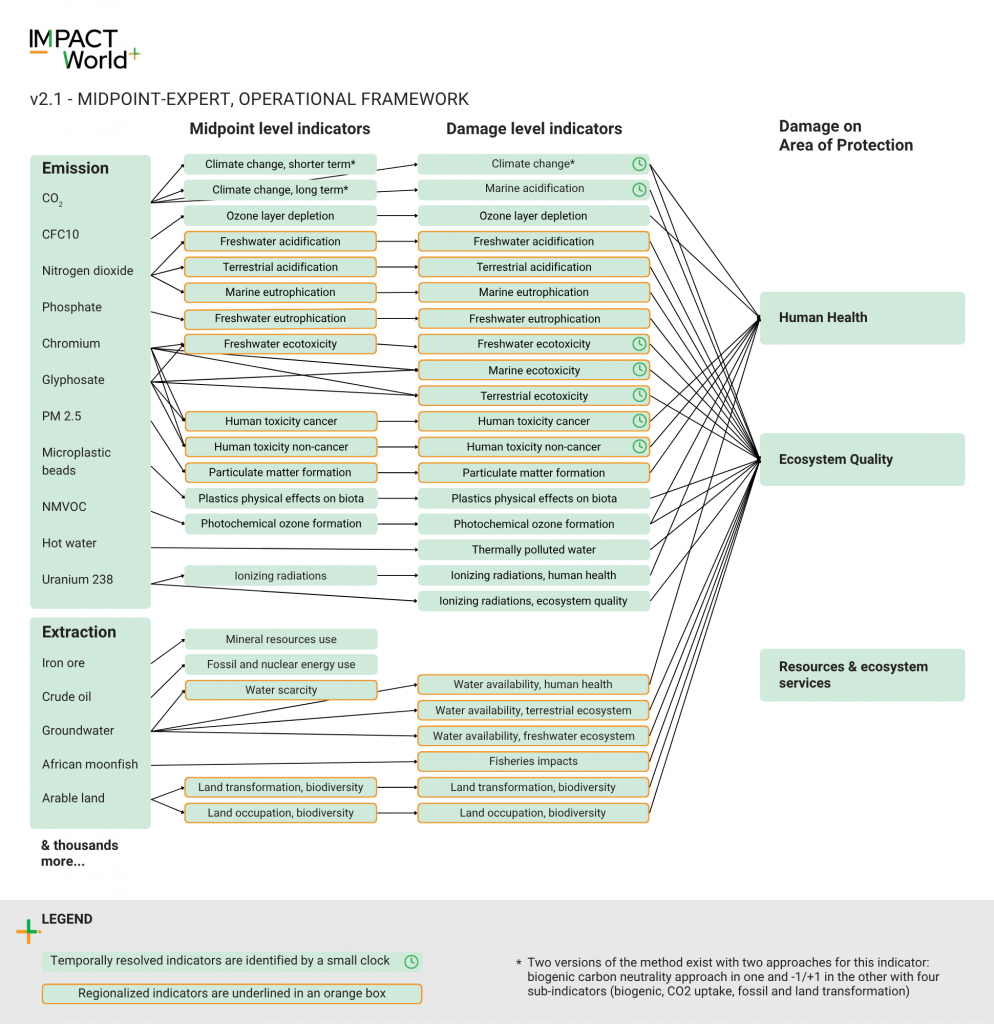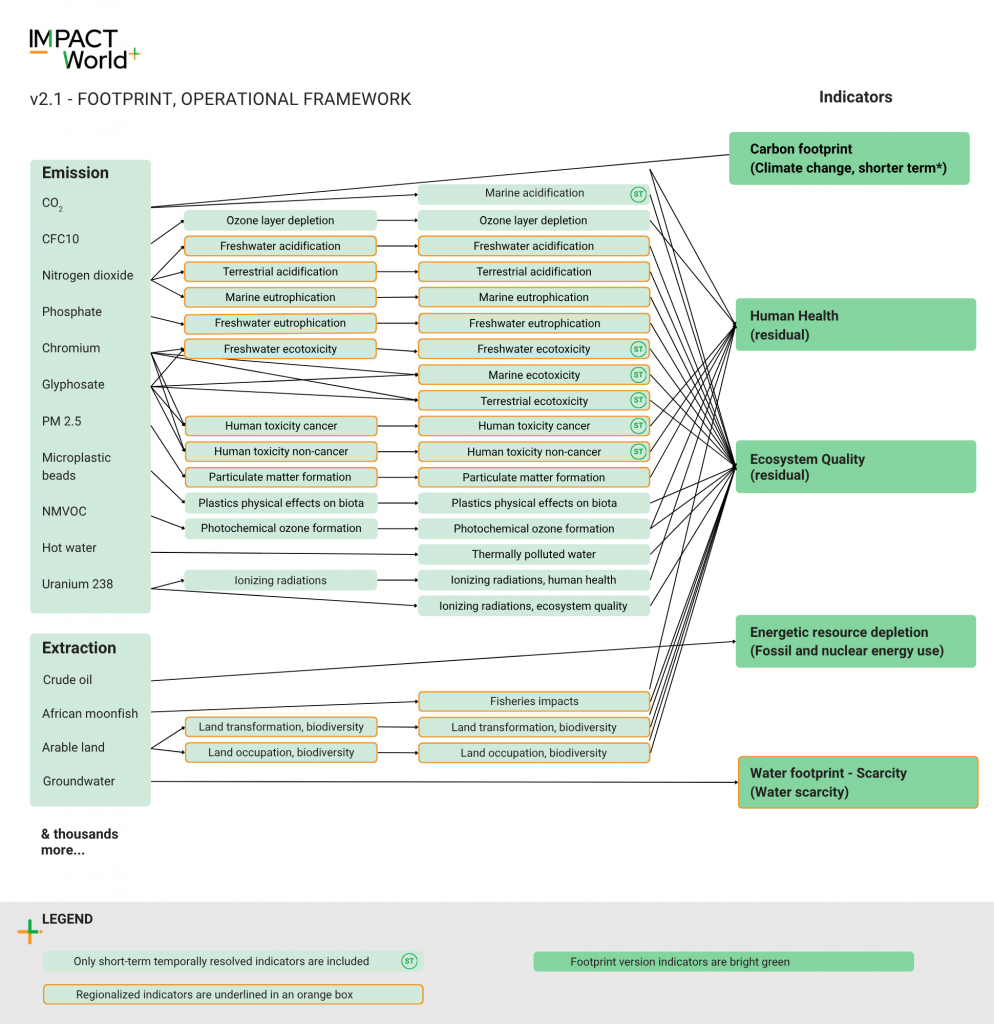Methodology
A globally regionalized method for life cycle impact assessment (LCIA).

IMPACT World+ integrates and builds upon the IMPACT 2002+, LUCAS, and EDIP methods. It is now the only method among them that is actively maintained and updated.
Time differentiation and impact regionalization
Most of the regional impact categories have been spatially resolved and all the long-term impact categories have been subdivided between shorter-term damages (over the 100 years after the emission) and long-term damages (between 100 and 500 years after the emission). IMPACT World+ provides consistent characterization factors for all regionalized impacts at four complementary resolutions: global default, continental default, country default, and native (i.e. original and non-aggregated) resolutions.
Three versions were developed for different levels of interpretation
Since v2.0.1, IMPACT World+ explicitly distinguishes three versions of IW+, namely the Expert version, the Midpoint version and the Footprint version. The Expert version is tailored for experienced users, the Midpoint version is intended for practitioners who prefer to operate at the midpoint level and the Footprint version is designed for practitioners with limited expertise in LCA and impact assessment.
Why this distinction ?
This explicit versioning builds on the recommendations of the original publication of IW+ by Bulle et al. (2019) to propose a simplified version that (i) offers stakeholders an impact profile closer to the environmental issues of concern, namely carbon footprint, water, and resources in addition to indicators addressing potential impacts on human health and ecosystem quality and (ii) allows for simplifications in methodological aspects that are still not mature enough to be readily understood during the interpretation phase by less experienced practitioners.
The Expert and Midpoint versions
The Expert and Midpoint versions encompass all recommended indicators, categorized at the damage and midpoint levels, respectively. The damage-level indicators are further aggregated into Areas of Protection (AoPs), specifically human health and ecosystem quality.

The two versions are separated because of the way impact assessment methods are operationalized in LCA software, which does not always allow the user to display midpoint and endpoint indicators separately, thus leading to potential misinterpretation of the results.
It must be noted that some indicators, such as fossil and nuclear energy use and mineral resources use, are only available at the midpoint level. Thus, if these indicators are considered of interest for a given study along with the AoP indicators, both versions of the method should be used.
Biogenic carbon accounting
The v2.1 update introduces two IMPACT World+ versions for handling biogenic carbon differently. The default “carbon neutrality” approach treats biogenic CO2 as neutral, with a null characterization factor. The “(incl. CO2 uptake)” version accounts for biogenic carbon like fossil carbon, with uptake characterized as negative (-1) and release as positive (+1). This version also separates climate change impacts into subcategories: fossil, biogenic, land transformation, and CO2 uptake, aligning with standards like PEF and GHG Protocol.
The Footprint version
The Footprint version aims at displaying indicators of general interest in decision-making (Carbon footprint, Energetic resource depletion, Water footprint – Scarcity) along with indicators ensuring comprehensiveness with respect to all the environmental issues considered in the Expert version (Human health (residual) and Ecosystem quality (residual)). The Footprint version is compliant with the optional ISO LCIA elements grouping.

The Carbon footprint indicator corresponds to the short-term impact category for Climate change (i.e., GWP100), as this time horizon is the one of interest to stakeholders. The Climate change, short term indicator is taken from the Midpoint version following the biogenic carbon neutrality approach, itself using the values of the AR6 report from the IPCC.
The Water scarcity footprint corresponds to the implementation of the Water scarcity indicator (AWARE 2.0) (the recommended indicator supported by a global consensus to assess water-related issues). It is taken from the Midpoint version. This indicator needs regionalized water flows to provide meaningful results.
The Energy resource depletion corresponds to the Fossil and nuclear energy use indicator taken from the Midpoint version.
The indicators Human health (residual) and Ecosystem quality (residual) derive from the AoP indicators Human health and Ecosystem quality from the Expert version, excluding the contributions of Climate change indicators and Water availability indicators to avoid double counting between the five Footprint indicators, and excluding all long-term indicators, as this time horizon is more uncertain and of lesser interest to stakeholders. As a result, these categories display significantly different outcomes compared to those in the Expert version, and should be interpreted differently.
Versions
IMPACT World+ is a continuously improved method. The latest released version is IMPACT World+ v2.0.1.
